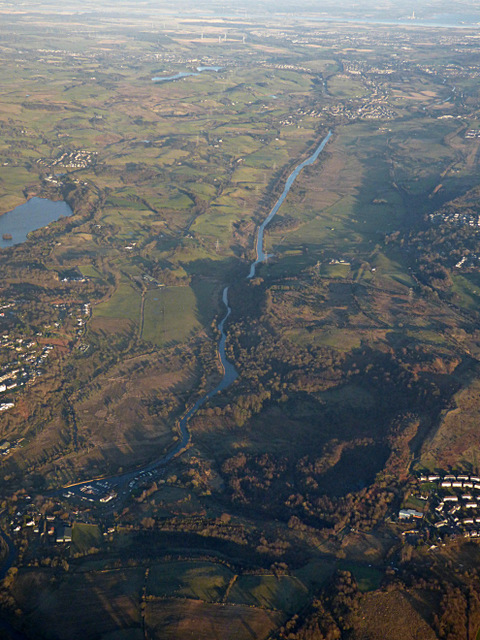Croy Hill on:
[Wikipedia]
[Google]
[Amazon]
 Croy Hill was a
Croy Hill was a 

 Croy hill's neighbouring forts were Barr Hill to the west and
Croy hill's neighbouring forts were Barr Hill to the west and 
 Croy Hill was a
Croy Hill was a Roman fort
In the Roman Republic and the Roman Empire, the Latin word ''castrum'', plural ''castra'', was a military-related term.
In Latin usage, the singular form ''castrum'' meant 'fort', while the plural form ''castra'' meant 'camp'. The singular and ...
, fortlet
A ''castellum'' in Latin is usually:
* a small Roman fortlet or tower,C. Julius Caesar, Gallic War; 2,30 a diminutive of ('military camp'), often used as a watchtower or signal station like on Hadrian's Wall. It should be distinguished from a ...
, and probable temporary camp on the Antonine Wall
The Antonine Wall, known to the Romans as ''Vallum Antonini'', was a turf fortification on stone foundations, built by the Romans across what is now the Central Belt of Scotland, between the Firth of Clyde and the Firth of Forth. Built some ...
, near Croy, to the north east of the village in Scotland
Scotland (, ) is a country that is part of the United Kingdom. Covering the northern third of the island of Great Britain, mainland Scotland has a border with England to the southeast and is otherwise surrounded by the Atlantic Ocean to ...
. Two communication platforms known as ‘expansions’ can be seen to the west of the fortlet. Alexander Park excavated the site in 1890-1891. Sir George Macdonald wrote about his excavation of the site which occurred in 1920, 1931, and 1935. At Croy Hill, the ditch in front of the rampart was not excavated by the Romans. It is likely that hard basalt
Basalt (; ) is an aphanitic (fine-grained) extrusive igneous rock formed from the rapid cooling of low-viscosity lava rich in magnesium and iron (mafic lava) exposed at or very near the surface of a rocky planet or moon. More than 90 ...
and dolerite
Diabase (), also called dolerite () or microgabbro,
is a mafic, holocrystalline, subvolcanic rock equivalent to volcanic basalt or plutonic gabbro. Diabase dikes and sills are typically shallow intrusive bodies and often exhibit fine-grain ...
of the hill was virtually impossible to shape with Roman tools. This is the only place along the Wall where the ditch wasn't dug. There is a bath house just outside one fort. A video reconstruction of the site has been produced.
At Croy Hill three religious objects have been found: one, as fragments of a relief of Jupiter Dolichenus; a second, an altar dedicated to Nymphs
A nymph ( grc, νύμφη, nýmphē, el, script=Latn, nímfi, label=Modern Greek; , ) in ancient Greek folklore is a minor female nature deity. Different from Greek goddesses, nymphs are generally regarded as personifications of nature, are ...
; and a third, identified as an altar to Mars
Mars is the fourth planet from the Sun and the second-smallest planet in the Solar System, only being larger than Mercury. In the English language, Mars is named for the Roman god of war. Mars is a terrestrial planet with a thin at ...
. Other artefacts found include a bronze arm purse, a storage jar filled with ashes, and a fragment of "face mask" jar. These items are now kept in the Hunterian Museum, Glasgow
Glasgow ( ; sco, Glesca or ; gd, Glaschu ) is the most populous city in Scotland and the fourth-most populous city in the United Kingdom, as well as being the 27th largest city by population in Europe. In 2020, it had an estimated popu ...
along with others like the altar found at Castlecary
Castlecary () is a small historic village in North Lanarkshire, Scotland, directly adjacent to the border with Falkirk. It has long been associated with infrastructure, being adjacent to a bridged river, a Roman fort and roads, a nationwide can ...
. Only four coins have been discovered near the fort and an axe was also found near the hill. A gravestone was discovered; it shows a soldier with other men, perhaps his sons, at his side. It has been scanned and a video produced.


 Croy hill's neighbouring forts were Barr Hill to the west and
Croy hill's neighbouring forts were Barr Hill to the west and Westerwood
Westerwood is an area in the north-east of Cumbernauld in North Lanarkshire, Scotland. Historically it was the site of a Roman Fort of which a video reconstruction has been produced. In the past two decades, new housing developments have been bu ...
to the east. The larger Roman forts of which this was not one had a nominal cohort of 1000 men but probably sheltered women and children as well although the troops were not allowed to marry. There is likely too to have been large communities of civilians around the site.

References
{{coord, 55.9651, -4.0308, type:landmark_region:GB, display=title Forts of the Antonine Wall